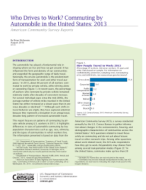Who Drives to Work? Commuting by Automobile in the United States: 2013
Who Drives to Work? Commuting by Automobile in the United States: 2013
Introduction
The automobile has played a fundamental role in shaping where we live and how we get around. It has influenced the form and density of our communities and expanded the geographic range of daily travel. Nationally, the private automobile is the predominant form of transportation for work and other travel purposes.1 In 2013, about 86 percent of all workers commuted to work by private vehicle, either driving alone or carpooling (Figure 1). In recent years, the percentage of workers who commute by private vehicle remained relatively stable after decades of consistent increase. For several individual years since the mid-2000s, the average number of vehicle miles traveled in the United States has either increased at a slower pace than in previous decades or declined.2,3,4 Although such shifts in travel behavior are slight, they have captured attention because they represent a disruption in an unequivocal, decades-long pattern of increased automobile travel.
This report focuses on patterns of commuting by private vehicle among U.S. workers in 2013. It highlights differences in rates of automobile commuting by key population characteristics such as age, race, ethnicity, and the types of communities in which workers live. The information presented is based on data from the American Community Survey (ACS), a survey conducted annually by the U.S. Census Bureau to gather information about changes in the socioeconomic, housing, and demographic characteristics of communities across the United States.5 ACS questions related to travel focus solely on commuting and do not ask about leisure travel or other nonwork trips. Among other questions about work-related travel, the ACS asks respondents how they get to work. Respondents may choose from among several transportation modes (Figure 2).6 In the United States, commutes make up less than 20 percent of all trips taken, but play an important role within the mix of daily travel by determining peak travel demand across transportation systems.7 This information is critical for tracking trends in travel behavior over time and informing transportation planning and policy decisions.
To explore recent changes in travel behavior, several 2013 estimates are compared to estimates from 2006, the earliest year of full ACS implementation.8 The analysis is limited to workers 16 years and older and employed during the ACS reference week. ACS commuting questions have served as the basis for several U.S. Census Bureau reports, but this is the first of such reports to take a comparative look at patterns of commuting by private vehicle.9
_________
1 U.S. Department of Transportation, “Summary of Travel Trends: 2009 National Household Travel Survey,” Technical Report No. FHWA-PL-11-022. 2011, <www.nhts.ornl.gov/publications.shtml>.
2 Michael Sivak, “Has Motorization in the United States Peaked?,” Transportation Research Institute, University of Michigan, 2014, <www.umtri.umich.edu/our-results/publications/has-motorization-us-peaked>.
3 Department of Transportation, “Beyond Traffic 2045: Trends and Choices,” 2015, <www.dot.gov/beyondtraffic>.
4 American Association of State Highway and Transportation Officials, “Commuting in America 2013: Brief 12 Auto Commuting 2013,” Washington, DC, 2015, <traveltrends.transportation.org>.
5 Estimates for Puerto Rico are not included in this report.
6 Commutes may involve multiple transportation modes, but ACS respondents are restricted to indicating the single mode used for the longest distance.
7 American Association of State Highway and Transportation Officials, “Commuting in America 2013: Brief 12 Auto Commuting 2013,” Washington, DC, 2015, <traveltrends.transportation.org>.
8 Data are based on a sample and are subject to sampling variability. Margins of error are presented for all estimates. A margin of error is a measure of an estimate’s variability. The larger the margin of error in relation to the size of the estimates, the less reliable the estimate. When added to and subtracted from the estimate, the margin of error forms the 90 percent confidence interval.
9 For more U.S. Census Bureau reports on specific commuting modes, see <www.census.gov/topics/employment/commuting.html>.
2009-2013 5-Year American Community Survey Commuting Flows
Visualizations
Others in Series
Publication
Publication
Publication





